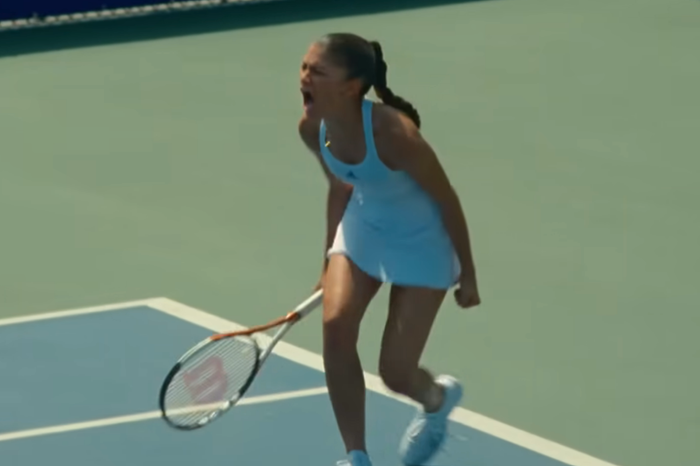
ItÔÇÖs hard to make actors look like athletes. A real athlete has training, nutrition, hyperspecific sports medicine, and years of muscle memory on their side; an actor gets weeks or a few months of training at most. Luca GuadagninoÔÇÖs new movie Challengers ÔÇö in addition to being a movie about three-way sexual desires and strange weather patterns in Westchester County ÔÇö is all about tennis, a sport that requires specific skills and becomes infinitely more complex in the upper echelons where its characters compete. Details like an athleteÔÇÖs foot placement, the turn of their waist, and the grip of their hands on the racquet can make or break a career. So how did Zendaya, Mike Faist, and Josh OÔÇÖConnor do?
According to real-life stars of the tennis world, pretty good! World No. 2 player Coco Gauff tweeted double claps in her review of the film; Serena Williams saw reflections of her fellow tennis players in the three main characters. Former U.S. Open champion Tracy Austin, covering the film for the Tennis Channel, told the three stars that their tennis looked ÔÇ£natural,ÔÇØ which is maybe the highest compliment for an actor playing an athlete. And sheÔÇÖs not wrong: IÔÇÖve been a rabid tennis fan since Andre Agassi was doing camera ads, and to my eye, Zendaya, Faist, and OÔÇÖConnor not only get their athletic forms right, they also embody specific tennis archetypes. Zendaya nails the physicality of TashiÔÇÖs powerful forehands and aggressive style of play. Faist plays up ArtÔÇÖs unfocused game as a youth and his controlled, elegant technique as a top-ranked adult. OÔÇÖConnor captures PatrickÔÇÖs jagged edges, stubborn service style, and petulant on-court antics.
WhoÔÇÖs Coaching?
It helps that Guadagnino knows how to film his actors to emphasize them at their best. Zendaya perfected her forehand with the help of former player and ESPN broadcaster Brad Gilbert. When heÔÇÖs not busy in the booth coming up with ridiculous nicknames for todayÔÇÖs players (if youÔÇÖve watched a match with Gilbert on commentary, youÔÇÖve likely heard his colleagues sigh in exasperation at least a few times), Gilbert is coaching Gauff. So itÔÇÖs no surprise that he has ZendayaÔÇÖs forehand looking dominant in the court scenes. At five feet, ten inches tall, Zendaya matches the height of some of the current gameÔÇÖs big hitters like Gauff and Madison Keys. SheÔÇÖs able to use that advantage to dictate the pace of her shot, hitting for both topspin and power. TashiÔÇÖs signature as a player is her intensity: As Art and Patrick watch her from the stands in her U.S. Juniors match, she doesnÔÇÖt let up on her opponent; she shows no doubt in herself and no mercy. In tennis, a sport where even the best players end up arguing with themselves on the court as they battle through rough patches, this level of focus is a weapon. Zendaya does intensity real well. (Just check out those last shots of Dune: Part Two if youÔÇÖre unsure.) Tashi maybe needed to concentrate more on her footwork, since thatÔÇÖs where she ended up injuring herself and prematurely ending her career, but we canÔÇÖt really blame that on Zendaya.
How Close Is Art Donaldson to GOAT Status?
For the most part, Guadagnino and screenwriter Justin Kuritzkes place their movie inside the real world of tennis. We catch a clip of ESPNÔÇÖs Mary Joe Fernandez talking about how Art has won each of the Grand Slam tennis tournaments twice ÔǪ except for the elusive U.S. Open. Later, when Art is preparing to take the court, we see posters of tennis players like Andy Murray, Andy Roddick, and Mardy Fish. Who we donÔÇÖt see is just as important: no Roger Federer, no Rafael Nadal, no Novak Djokovic ÔÇö┬áthe three players who have dominated menÔÇÖs tennis for 20 years. ItÔÇÖs a canny detail, since there is no world where Art Donaldson is a six-time Grand Slam champion if those three men exist.
This raises the question: If the Big Three donÔÇÖt exist, is Art the best tennis player of his era? HeÔÇÖs got six Slam titles, which puts him in the company of greats like Stefan Edberg and Boris Becker. HeÔÇÖs one behind John McEnroe and two behind Andre Agassi and Jimmy Connors. Djokovic, Nadal, and Federer currently top the list of Slam titles at 24, 22, and 20, respectively, but if those three donÔÇÖt exist, the record probably still belongs to Pete Sampras at 14. ArtÔÇÖs about halfway to Pete, so not GOAT status, but certainly among the greats of his era.
The Roger and the Rafa?
Faist and OÔÇÖConnor represent two very different archetypes in menÔÇÖs tennis, and one of the great accomplishments of Challengers is how astute it is about their dynamic. On the court, Art plays with the precision of a Federer and the svelte grace of Djokovic. Art is even decked out in a Uniqlo-branded kit of crisp whites, pulling him closer to the Federer/Djokovic vibe. YouÔÇÖd think that would make Josh OÔÇÖConnorÔÇÖs Patrick Zweig the Nadal, with his sleeveless tees and relentless court coverage. But while there are definitely elements of that, OÔÇÖConnor has said that he patterned his character after AustraliaÔÇÖs combative, controversial, and outright bratty Nick Kyrgios. Regardless of inspiration, Guadagnino harnesses the iconic power of this sartorial clash of styles: Uniqlo polo (centered, prepared, ungodly talented) versus the sleeveless tee (mouthy, disrespectful, will run you ragged), and Faist and OÔÇÖConnor reflect those archetypes perfectly.
ArtÔÇÖs One-Handed Backhand vs. PatrickÔÇÖs Wonky Serve
In terms of their form, the men have also clearly done their homework. Aided by Guadagnino cranking up the racquet-on-ball sound effects to nerve-jangling levels, their ground strokes have power. Art, true to his classic form, employs the one-handed backhand, one of the most elegant things you will ever see in the world of sports. Most players, especially nowadays, put two hands on the racquet while hitting a backhand in order to generate maximum power. The one-handed version is not only a flex, but it extends the reach of the player as theyÔÇÖre covering the court. Properly deployed (look up players like Stan Wawrinka, Grigor Dimitrov, or Federer to see how it ought to be done), itÔÇÖs the closest tennis comes to professional dance.
On the other side of the net, OÔÇÖConnorÔÇÖs serve as Patrick is a total disaster ÔÇö he starts with his racquet perched on his shoulder, forgoing any kind of windup and forcing himself to generate all his power from his upper body, like heÔÇÖs throwing a tomahawk. ItÔÇÖs not unheard of as a service motion; American Jay Berger was notorious for it in the early ÔÇÖ90s. But itÔÇÖs far from optimal. In one of the flashbacks, we see Art lightly hector Patrick for his goofy-ass serve, and itÔÇÖs an early indication that Art is looking to perfect his game while Patrick is getting by on raw talent and what feels good to him.
The Grunts
The match that begins and ends the film features easily the loudest and most kinetic tennis scenes put to film. Trent Reznor and Atticus RossÔÇÖs club-ready soundtrack thumps around the action. Guadagnino giddily has Faist and OÔÇÖConnor drip sweat onto the camera lens. Even the grunts in the third set ÔÇö yes, the male players also grunt ÔÇö feel natural and not actorly. ThereÔÇÖs a misconception that grunting in tennis is merely ornamental, but itÔÇÖs usually the by-product of the players heaving all theyÔÇÖve got into one shot.
The Impossible Volley
Challengers ultimately takes a handful of demerits for the climactic rally of the final match, though not because Art is able to leap so high into the air for a smash that he nearly clears the net. ItÔÇÖs the flurry of volleys that happen right before that. In tennis, volley exchanges are fast, frantic, and thrilling. But they usually donÔÇÖt last very long ÔÇö and when they do, itÔÇÖs because players have to stretch to the side or dive or leap or run around a lob. Guadagnino has Faist and OÔÇÖConnor volleying straight forward to each other, in a way that, were this being filmed in a two-shot, might look like two boys playing with those wooden paddleballs connected by a rubber band.
ThatÔÇÖs the nitpick, though ÔÇö one unrealistic exchange in a movie full of good form, good fitness, and good on-court snack representation (bananas and energy gels, LFG). If I were bold enough to sneak a baseball metaphor in here, IÔÇÖd say the movie has a great batting average. In tennis terms, its first-serve percentage is strong.


